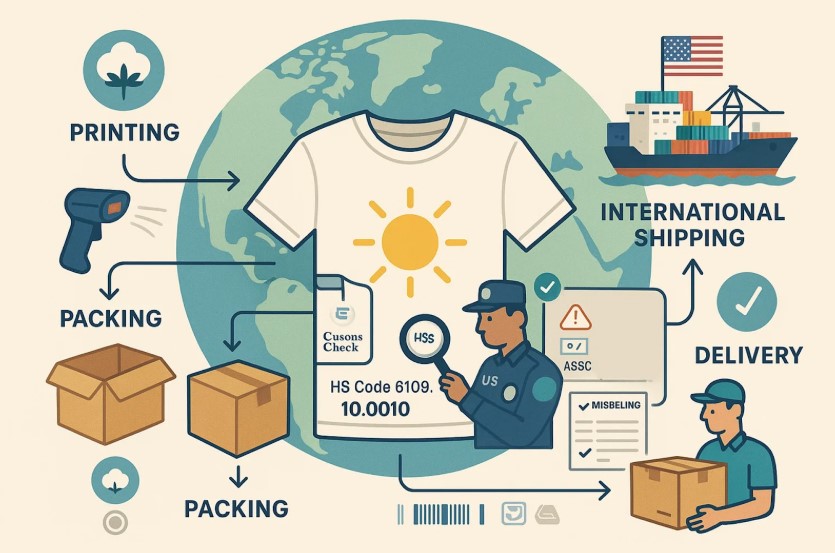Starting a t-shirt printing business is an attractive choice now. Low startup costs make entry accessible to almost anyone. Versatile customization concepts let you serve niche markets. Massive demand spans fashion, merchandise, and corporate branding sectors. Easy scaling through print-on-demand or wholesale models means you can grow without massive upfront investments on inventory and everything else.
The whole idea may seem simple but behind the shipment of t-shirts across borders lie a web of trade codes and regulations. The global t-shirt trade is huge. So starting a custom t-shirt business with plans to move into international markets comes with more than a few challenges.
You can print a unique design, run ads, or source cheap t-shirts wholesale awaiting an influx of orders, but if you mislabel your package, your profits can vanish at customs.
Understanding how your tees move across borders is absolutely vital.
HS Codes: The Language of Global Trade
The Harmonized System (HS) is how the global trade engine identifies goods. It’s basically the universal product classification method tied to international commerce. Every item you ship has a number – the HS code. That number affects duties, taxes, and if customs lets your goods through or holds them.
HS codes start with a 6-digit base that remains the same globally. Countries then extend these codes to 8 or 10 digits to meet their specific regulatory needs. The United States uses a 10-digit system called the Harmonized Tariff Schedule of the United States (HTSUS). For t-shirts, the system is specific. Cotton t-shirts? One code. Synthetic tees? A different one. Misclassify your shirts and you could face incorrect duty, shipping delays, and even penalties for compliance violations.
HS Code for T-Shirts
Let’s take a cotton crewneck tee. Its HS code starts with 6109.10. The numbers actually mean something. For this product,
- 61 represents apparel that’s knitted or crocheted
- 09 specifically identifies t-shirts and vests
- .10 indicates cotton as the primary material
Switch the fabric, change the code:
- 6109.90 = Synthetic fiber tees
- 6109.20 = Man-made fiber
- 6109.30 = Linen or hemp
The U.S. often extends these codes further to 10 digits. For example:
6109.10.0010 for Men’s cotton t-shirt, while women’s cotton t-shirts use 6109.10.0020. These codes go on shipping forms, invoices, and entry paperwork, and are not optional. Remember that the numbers also affect tariff rates. Some countries impose extra duties on synthetic fibers. If your shirt’s label says polyester but your form says cotton, it’s a red flag.
Here’s a quick reference table that might help.
| Material Type | Base HS Code | US-Specific Example |
| Cotton T-shirt | 6109.10 | 6109.10.0010 (Men’s) |
| Synthetic T-shirt | 6109.90 | 6109.90.1010 |
| Man-made Fiber T-shirt | 6109.20 | 6109.20.0010 |
| Linen/Hemp T-shirt | 6109.30 | 6109.30.0010 |
U.S. Apparel Import Rules You Need to Know
- Labeling: All imported clothing must state fiber content, country of origin, and care instructions.
- RN Number: U.S. importers must have a registered identification number.
- Forced Labor Compliance: Any t-shirts made with Xinjiang cotton or similar sources can be detained or banned. This cotton ban specifically prohibits imports from China’s Xinjiang region due to human rights concerns.
Yes, the U.S. takes textile imports very seriously. Officials are thorough in inspecting documentation and sourcing.
Even if you want to export a batch of long sleeve t-shirts wholesale to just Canada, you will need:
- Commercial invoice
- Packing list
- Bill of lading
- Matching HS code on all documents
Finding the Right Code
The U.S. Harmonized Tariff Schedule (HTSUS) is public and they update it periodically.
- Use USITC’s HTS Search Tool
- Ask your supplier what they use
- Hire a licensed customs broker if shipping large quantities
Essential Paperwork Best Practices
The information in the documents must be consistent. Use identical HS codes on your commercial invoices, packing lists, and shipping documents.
That means:
- Detailed product descriptions
- Exact quantities and units
- Material composition and HS code
- Unit value and total cost
- Country of origin
- Supplier and buyer information
You are right. This is a little complicated, and can get a little more complicated if you mess up at any point. But you won’t mess up if you know the details. The t-shirt business offers more than enough opportunities for entrepreneurs willing to learn the rules.
Compliance isn’t glamorous but it’s how you keep your brand protected. Understanding HS codes and US clothing export laws makes all the difference between successful international shipments and struggles with compliance issues. If you learn the fundamentals, global expansion becomes real for your brand. Miss a step, and your best products will be stuck at the port.


